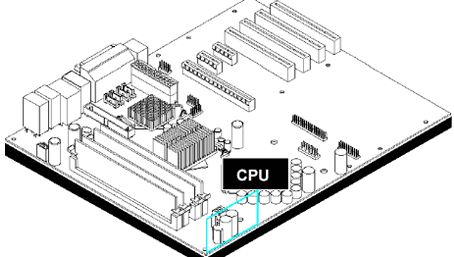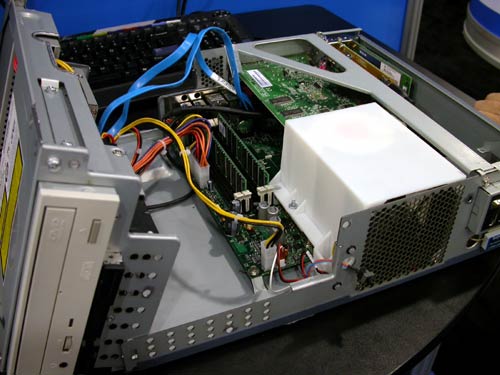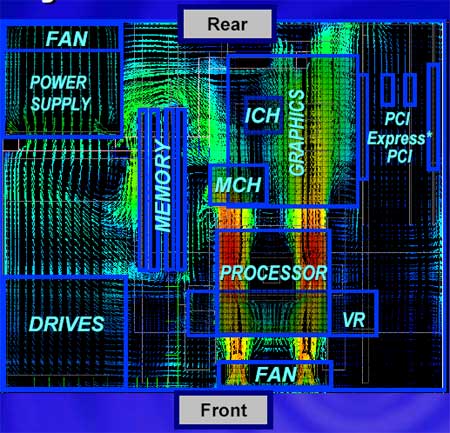Balanced Technology eXtended (BTX) Form Factor - The Future of Cases & Motherboards
by Anand Lal Shimpi on September 18, 2003 12:34 PM EST- Posted in
- Cases/Cooling/PSUs
BTX - The Basics
Just in case you were told otherwise, the BTX form factor is largely incompatible with the ATX form factor - the only area where this doesn't fully apply is in power supply support, as you can use ATX power supplies with BTX motherboards (more on this later).
In order to understand BTX you have to understand the motives for change. CPUs are getting hotter, graphics cards are as well, and despite all of these increases in thermal dissipation there is an increase in demand for quieter PCs. Today's ATX cases and motherboards were not designed for the incredible levels of heat that they have to deal with, and it is with this that we begin our understanding of BTX.
Pictured below you will see a BTX motherboard reference design:

The first thing that you'll notice about the BTX form factor is that the expansion slots have switched sides. In the picture above you'll see a total of 7 slots, from left to right we have a PCI Express x16 slot, two PCI Express x1 slots and four 32-bit PCI slots. Note that the slot closest to the CPU is the PCI Express x16 slot, which will be used for graphics, allowing it to share some of the CPU's cooling.
The redesign of the board layout was done in order to improve airflow through the system; moving the CPU to the "front" of the case allows it to be right next to the intake fan, giving it the coolest air out of any component in the system. You will then notice that the chipset is directly in line with the CPU, allowing airflow over the CPU's heatsink to be channeled over those heatsinks as well before exiting the case. This direct line of airflow allows for very efficient cooling of not only the CPU, but the voltage regulators, chipset and graphics card.
The memory slots have been moved to the left edge of the motherboard, but are also able to receive cooling courtesy of the thermal module, as it is known, that is mounted over the CPU. You can see a good example of what the thermal module will look like below:

The white plastic duct encloses what is known as the "thermal module," which at this point is basically a heatsink and a fan. In the future, the thermal module could encapsulate some more exotic cooling forms such as heatpipes or potentially even water cooling. In this particular design, the fan seen above is a 90mm unit.
In order to understand the cooling flow within a BTX system, take a look at the picture below:

In the depiction above the graphics card is mounted on a riser card, although it can also be mounted vertically.










99 Comments
View All Comments
Anonymous User - Friday, September 19, 2003 - link
Yeah, this new thing is going to be shoved down our throats to make a few extra bucks. Nobody is fooled by this. The posts are right, this isn't innovation. There doing this to make more money and save costs. The problem is the saving will not be passed to the consumers. Soon you will be forced to buy plastic everything.Galvin - Friday, September 19, 2003 - link
I think Asus will make ATX style boards with PCI express on it. Least this way we can upgrade to pci-express without throwing away our expensive cases.As far as cooling I have no problems with it at all. Lian-li all illuminum case and all copper heat sink from zalman do more than enough cooling.
This new case design is nothing but people to spend a lot of cash. But like I said I think will be able to get pci-express ATX boards from makers like asus, so no need to jump this new BTX crap right away.
Anonymous User - Friday, September 19, 2003 - link
Well I am personally not impressed.Not providing AGP support at all is going to delay enthusiasts from switching to the new Form Factor.
Saturating the cool air immediately by passing it over the CPU and then passing it over the other components is a big mistake as by that point it will be significantly less affective at cooling as you cannot increase the volume of air flowing over those components to compenesate for the higher than ambient temperature you have now.
They should be looking at putting more active cooling into the current format before putting this BTX crap out
Anonymous User - Friday, September 19, 2003 - link
Are we ever going to see the PCI Express systems allow for multiple video cards? With new video cards, they allow multiple outputs for monitors. I still think it would be nice to have three screens being pushed by different video cards. I was never aware of Intel building a chipset that would support two AGP slots. Is this PCI-X16 slot strictly for video or can you stick your video card wherever you want if you have a mobo full of PCI-X slots?Anonymous User - Friday, September 19, 2003 - link
Intel wanting more royalties mayhaps? Wouldn't be the first time they changed somthing with that as the primary goal.n0d3 - Friday, September 19, 2003 - link
it's not so bad really,by flipping the case, add on cards are finally facing chips upwards again, and that is a lot better then having them downwards. it can get rid of the heat easyer. And the CPU beeing infront isn't really that new either, a lot of socket7 boards where like that.
Anonymous User - Friday, September 19, 2003 - link
Change for the sake of change... or control of the motherboard, power supply, and case industries. You take your pick based on your view of Intel. None-the-less, the only thing worthwhile in the whole BTX design is the cooling. The right swapped to left is in a word "unnecessary." Just flip the pictures in this report left to right in your mind and you'll see that there was no compelling reason for the change... unless you subscribe to a darker image of Intel (as I do) that this is as much about controlling the industry as it is about innovation or change for the better.Anonymous User - Friday, September 19, 2003 - link
#15, there are PS/2 keyboard and mouse to USB converters. :) I have a couple IBM Model M too, best keyboards ever! :))On the other hand, USB for mouse and keyboard SUCKS!!! USB has high latency, and uses lots of processor time, **total crap** for gaming control!! :((
McCarthy - Friday, September 19, 2003 - link
Miss the old Articles forum...Anonymous User sure talks a lot.I guess I'm missing the point of BTX too. For OEMs having the 'thermal module' upfront so they can use the combine the functions of CPU heatsink's fan and case fan will reduce cost slightly, but then Dell's already been doing this quite effectively as is with their neon green duct. Removing Parallel-Serial-PS/2 is a function of the ATX backplane included with the moterboard, as made ever so obvious by including parallel and PS/2 in the BTX example case. The most innovative thing I'm seeing from the examples you were given is the notched PSU allowing for a skinnier case.
What I don't see are demands for uniform motherboard-case plugs for Power/Reset/lights. I'm also failing to see how having the motherboard face the other way makes PCI Express or Serial ATA any easier a transition. Frankly, aside from allowing OEMs to have a nice centrally mounted grating for the input fan over their 'thermal module' rather than an offset one in the back, I don't get the point at all. Looks like a 1964 and a half Ford revision where nothing is really changed, but parts houses and mechanics get overhead because of it.
Serp86 - Friday, September 19, 2003 - link
LOL.My 9 year old pentium 1 60mhz board had this config. only the case had a 120mm fan instead of the 80!!!
Who called this "innovation"!?
LOL. In Intel's Face.